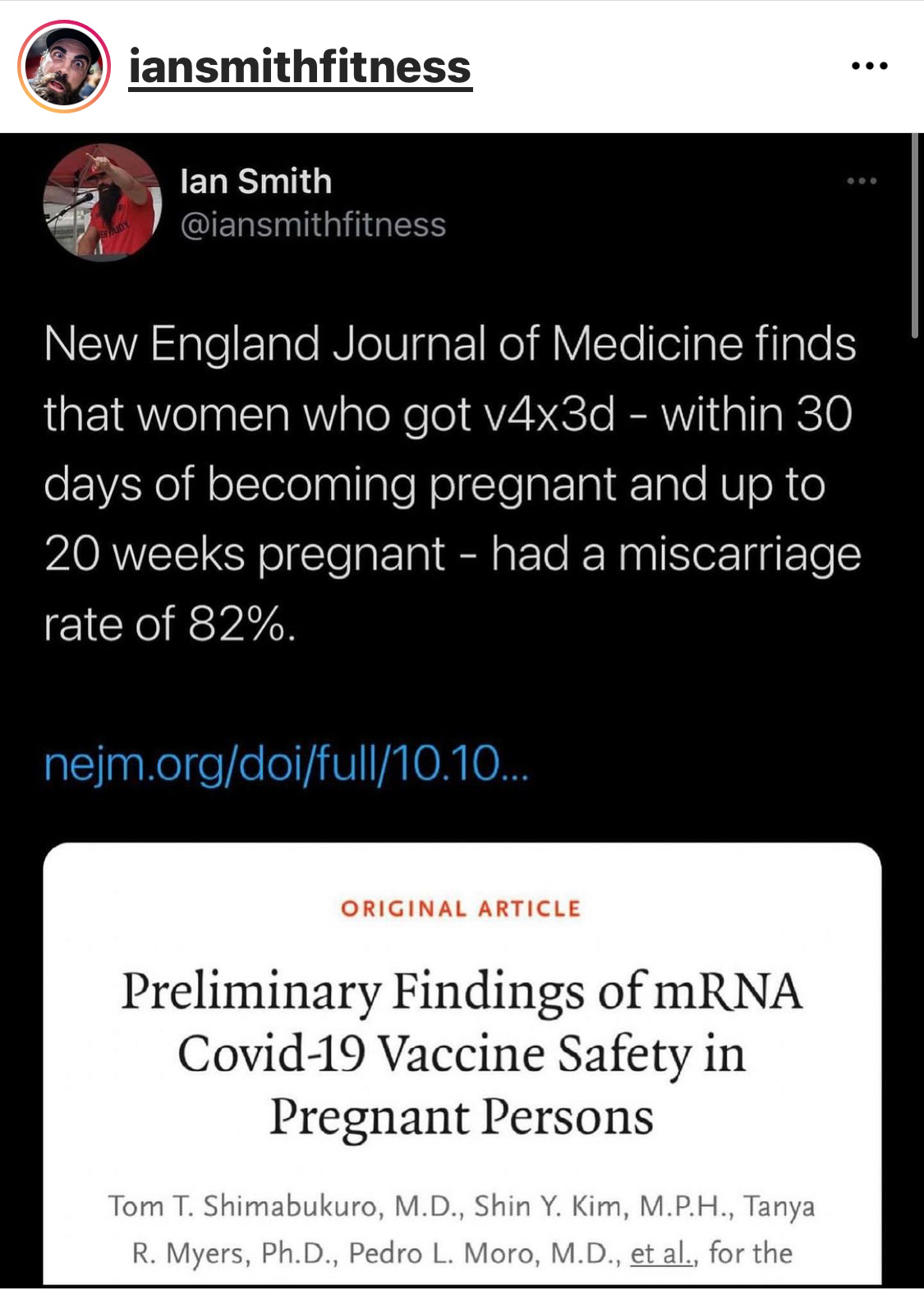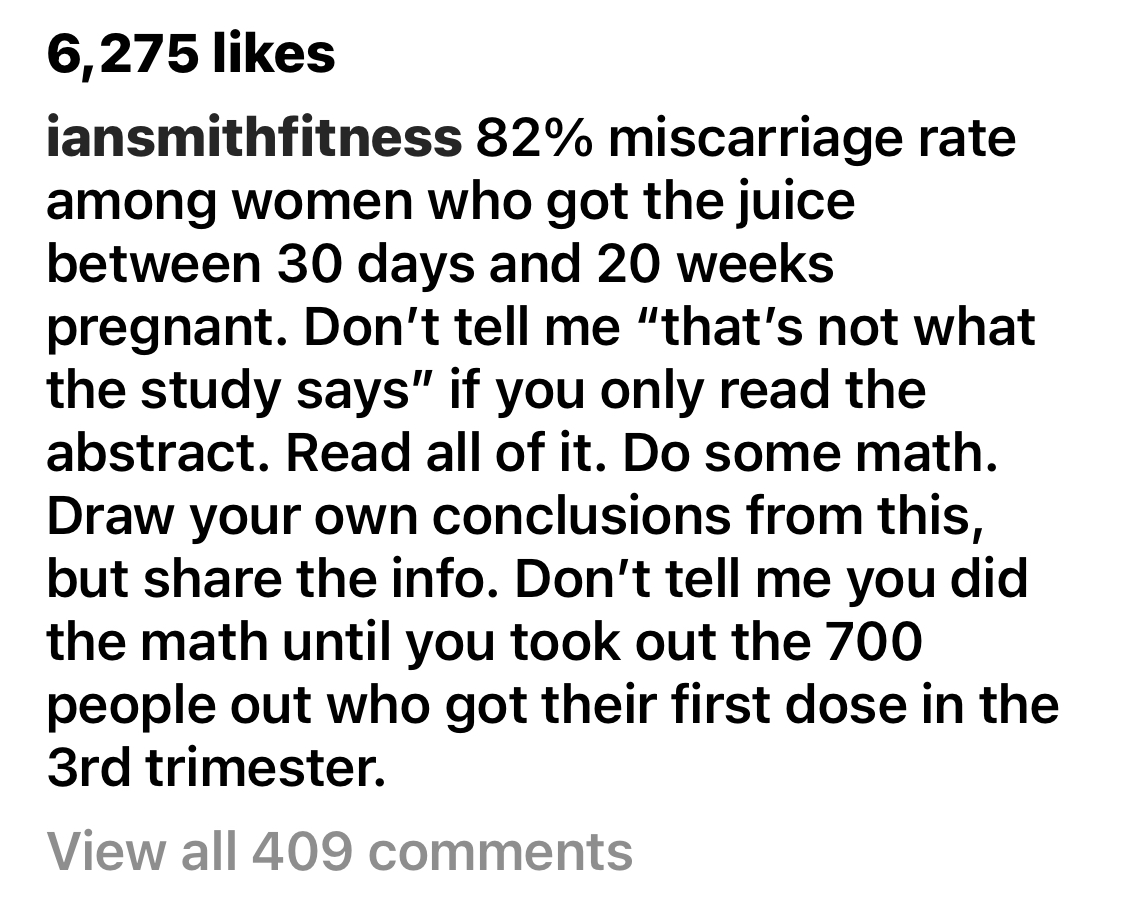No, the Covid-19 Vaccine DOES NOT have an 82% rate of miscarriage
Correcting yet another lie about the vaccine and the reproductive tract
The latest false claim about the Covid-19 vaccine is that the authors of the recent study about the safety of the Covid-19 vaccine during pregnancy, published in the New England Journal of Medicine (link here), incorrectly calculated the rate of miscarriage among those who received the vaccine. Instead of a 12.6% miscarriage rate as reported in the paper, the people making this claim state the miscarriage rate is 82%.
Yes, somehow all the experts, thousands if not tens of thousands, who have read this paper didn’t catch the mix up, but fortunately the league of armchair epidemiologists is on the case!
I was originally sent this post on Instagram from someone with over 300k followers, but I have since seen similar claims elsewhere.
The comments on this post are a sad echo chamber of conspiracy theories and vaccine disinformation. There are some people who attempted to correct the poster, but the ratio of “vaccines are evil” to “hey, your analysis is wrong” is depressing.
This would be a joke, except people are dying from the virus and they are almost all unvaccinated. For perspective, in June every person who died from Covid-19 in Maryland was unvaccinated.
Study Background
The study in “question,” using “in question” very loosely, is an analysis of the V-Safe registry as well as data from VAERS (Vaccine Adverse Event Monitoring system). The data “in question” is only from the V-Safe registry, so we’ll confine our discussion to that part of the paper.
V-Safe is a voluntary smartphone based surveillance system that tracks Covid-19 vaccine side effects and complications. People sign up and the V-Safe registry sends texts to participants with links to surveys and follow-up continues for 12 months after the last dose of the vaccine. One of the questions is about pregnancy, and people who indicate they were pregnant when they were vaccinated, or think they were pregnant, are then contacted by phone to get more detailed information on the pregnancy outcome as part of the V-Safe pregnancy registry. A total of 5230 people who reported being vaccinated during pregnancy were contacted and 3958 were subsequently enrolled in the pregnancy registry. The reason the numbers dropped is they couldn’t contact some, some people declined, and others weren’t actually pregnant. The only vaccines given to participants were the Pfizer-BioNTech and Moderna.
This is the breakdown of when the vaccine was administered during the pregnancy for these 3958 people:
Preconception: 92 (2.3%)
First trimester: 1132 (28.6%)
Second trimester: 1714 (43.3%)
Third trimester: 1019 (25.7%)
Unknown: 1 participant
Full data isn’t yet available for all of these participants as many were still pregnant at the time the study was written. Also, it takes time and people power to contact thousands of people.
To evaluate pregnancy outcomes the investigators looked at completed pregnancies, meaning the pregnancy resulted in a live birth, a spontaneous abortion (miscarriage), an abortion, ectopic pregnancy, or a stillbirth. There was complete data on 827 people. The non-existent smoking gun lies in these numbers. Of these 827 people, 712 had a live birth (86.1%), 104 a spontaneous abortion or miscarriage (12.6%), and 1 a stillbirth (0.1%), and 10 (1.2%) had an ectopic pregnancy or induced abortion.
Some of this data is presented in Table 4, and it is this table that is “in question.”
These spontaneous abortion (miscarriage) numbers are exactly in line with what we typically see, meaning the miscarriage rate (loss before 20 weeks) is typically 10-26%.
So where does this supposed 82% rate of miscarriage come from? Well, 700 of 712 pregnancies that produced a live birth were vaccinated in the third trimester, so what these armchair epidemiologists did was remove those 700 from the data and claim that instead of miscarriage rate being 104/827 it is now 104/127 or 82%. But you can’t do that because the data set is looking at all pregnancy outcomes. Of course when you remove those 700 pregnancies the miscarriage rate looks artificially high, because the only way a person got into the data set for table 4 was if the pregnancy had ended and they had been vaccinated.
If you want to look at the pregnancy outcomes from vaccination in the first or second trimester then the denominator needs to be all pregnancies vaccinated in the first trimester (14 weeks) or up to 20 weeks or 24 weeks (the number of weeks just needs to be consistent). The investigators have initial data for 1040 people vaccinated in the first trimester (≤ 14 weeks) and 1700 vaccinated in the second trimester (≥ 14 weeks to 24 weeks). These pregnancies will eventually form the denominator to look at vaccination in the first and second trimesters, but these pregnancies have to end and all data needs to be collected before they can be used. The researchers specifically mention they don’t have follow up data for people vaccinated early and the rate of miscarriage may change when they have more data. Anyone concerned about Table 4 only had to read the full article.
In Table 4 we see 104 losses before 20 weeks. The gestational age of the stillbirth isn’t listed, but we’ll say for the sake of discussion it happened before 24 weeks, so now we have 105 pregnancy losses of people vaccinated in the first or second trimester. We could make an argument that the pregnancy loss rate for a first or second trimester vaccination is 3.8%, which is much lower than expected, as 105 divided by 2740 (the number of vaccinations in the first and second trimester) is 3.8%. But we won’t say that because we don’t have the full data on the outcome of these pregnancies. (Note that if we did that, it would be a similar mathematical error the armchair epidemiologists made, but in the opposite direction. Ha! See, it’s easy to abuse the data to get the outcome that you desire).
In a different study researchers assessed the safety of the vaccine in very early pregnancy by looking at the implantation rate of embryos during IVF from people who were vaccinated, those who previously had Covid-19, and those who were unvaccinated and never had Covid-19. The implantation rates were the same for all groups, meaning being vaccinated did nothing to prevent conception. This is exactly as we would expect, but it’s always great to have the confirmatory science. This should be very reassuring.
Covid-19 rates are on the rise again and the only people dying are those who haven’t been vaccinated. Stoking lies about the vaccine is literally getting people killed and pregnant people are at higher risk of death, so this lie may deter vaccination among those who need it most.
There is no conspiracy to hide miscarriages here, just an abuse of statistics.









I was fully expecting to read the paper and find that the authors maybe didn’t make the follow-up issue explicit enough. But no, there’s an entire paragraph in the discussion. Statistics is hard and innocent mistakes are common but the paper explicitly says there isn’t enough follow-up data yet to make comparisons by vaccine timing. Thanks for writing this post! It is so helpful to have something to link to if I spot this misinformation being spread by anyone I know.